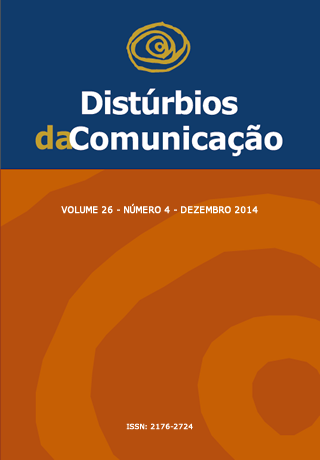Eficácia da Terapia da Entonação Melódica Adaptada: Estudo de Caso de Paciente com Afasia de Broca
Palavras-chave:
Reabilitação, Afasia de Broca, Linguagem, Música, Neuropsicologia.Resumo
Introdução: A preservação da habilidade de cantar tem sido utilizada para promover a recuperaçãolinguística de pacientes afásicos com défices expressivos, sendo designada como Terapia da EntoaçãoMelódica (TEM). Objetivo: Testar a eficácia terapêutica de um programa de reabilitação de linguagematravés da música, com base na TEM, numa paciente com diagnóstico de afasia de Broca pós AcidenteVascular Cerebral (AVC) no hemisfério esquerdo (HE). Método: Desenho experimental de caso únicodo tipo AB com múltiplas linhas de base. Participante: sexo feminino (G.), destra, 46 anos de idade,pós AVC isquêmico há aproximadamente cinco anos com consequente afasia de Broca. Procedimentos:avaliação neuropsicolinguística antes, durante e no final da terapia. O tratamento ocorreu durante trêsmeses, em dois encontros semanais (24 sessões). Resultados: Importante melhora na fluência verbal,havendo um aumento do número de palavras produzidas por minuto durante o discurso conversacional,redução das anomias, melhora na sintaxe e na dispraxia de fala. Quanto às funções neuropsicolinguísticas:melhora no desempenho da paciente nas funções de atenção, memória de trabalho, memória verbalepisódico-semântica (reconhecimento), memória prospectiva, nomeação, leitura em voz alta e escritaespontânea e ditada. Conclusão: as funções neuropsicolinguísticas não envolvidas no processo da TEMpermaneceram com desempenhos iguais nas avaliações inicial e final, indicando que as melhoras de G.nas demais funções ocorreram em virtude da intervenção. Desta forma, pode-se concluir que a TEM semostrou eficaz para um caso de afasia de Broca.Downloads
Não há dados estatísticos.
Métricas
Carregando Métricas ...
Downloads
Publicado
2014-12-01
Edição
Seção
Artigos
Licença
Copyright (c) 2015 Denise Ren da Fontoura, Jaqueline de Carvalho Rodrigues, Lenisa Brandão, Ana Maria Monção, Jerusa Fumagalli de Salles

Este trabalho está licenciado sob uma licença Creative Commons Attribution 4.0 International License.









